

Click on thumbnail for big photos.
Mary Hare is renowned for having music as part of the curriculum. Music as a formal subject was introduced by Martin Williams and
Mr. William G. Fawkes in 1975 although in previous years, a few pupils were given private tuition on the piano by visiting teachers, or from the school staff, such as Francis Webb. Also, some pupils showed off their musical talents by playing guitars, and other instruments at the Talent Contests in the late 1960s. The introduction of music to the school was made possible through two factors - better individual hearing aids and adherence to the National Curriculum.
This chapter charts the music revolution at Arlington Manor by reprinting extracts from magazines, such as
The Bluebird,
The Phoenix, and
Chatterbox.
A group of seniors had the idea of a rock group and a disco club. Martin Williams spoke with Mr. W.G. Fawkes, who was a very keen musican with a good working knowledge of other musical instruments.
Lumpy Custard the school's first pop group, was formed by Mr. Fawkes and consisted of Martin Williams, Robert Nolan, and Mark Shaw. Lumpy Custard events frequently included performances by a dance troupe of three partially hearing and two profoundly deaf girls called the “Lovebugs” who danced to several ABBA tunes.
A recorder group was formed and brought large numbers of girls to the lessons. Whenever a form-class had to do the prayers and bible-readings in morning assembly, the class played percussion instruments.
A junior group called `DAD“ was formed around the same time as Lumpy Custard. `DAD“ came from the first initials of the band members, `D“ for Dick (Richard Cole was never called Dick, but this was for the purpose of naming the group), `A“ for Albert Thomson and `D“ for David Nelson. DAD, being the second and more junior group (at the time Robert Nolan and Martin William left Mary Hare in 1976) was mainly used for school assemblies; whereas Lumpy Custard was mainly used to play a few pop tunes at the school discos at the weekend with flashing lights and amplifiers in the Dulverton Hall.
Word of mouth music at Mary Hare began to attract the attention of the local community. In 1976, Lumpy Custard was showcased among the several activities at Mary Hare in a special edition of the national television news magazine “Pebble Mill at One”. This was followed by the school”s participation in the annual Christmas Concert given by local schools which proved to be emotional when the audience gave the longest and loudest round of applause of the whole evening.
There had been an increasing interest in music. Instrumentalists included descant, treble, tenor and bass recorder players, three flautists, a clarinettist, a trumpeter and several guitarists and pianists. There were weekly practice sessions, during and after school, thanks to the co-operation of Mr. Fawkes and Mr. Halliday.
Music could be heard all over the place; in classrooms, dormitories, the hall and also in the music room. Some concerts were held, mostly around Newbury. These were for parents of children at other schools, scout groups, and one for occupational therapists.
Ezra Rachlin, the eminent conductor, and his wife Ann were so enthralled by the recorder group in a visit to the school that the group was invited to a concert at the Royal Festival Hall celebrating the 50th birthday of fellow conductor Lorin Maazel. The group performed an arrangement of “Happy Birthday” at a champagne reception in the presence of HRH The Prince of Wales during the interval. An accompanying painting competition led to criticisms that there was no room for “expressive” teaching in deaf education (
fawkes_1981_Levi.pdf).
The performance was shown in the following edition of “News Review”. Subsequent television appearances were on “Nationwide”, “Day by Day” and “Pebble Mill at One”.
The remarkable feat – that as many as 40 pupils in a specialist school for the deaf were playing musical instruments – resulted in a steady stream of visitors to see how this was possible. Pupils formed their own bands. ISIT which was based on the first initial of the band members (Ian Munday, Tony Ellison, Stuart Harrison, and Ivor Williams) and consisted of drums, guitar, vocal and bass guitar; the latter was a favourite among the lads.
They began with Elvis Presley's `Jailhouse Rock“ then turned to Status Quo's `Softer Ride“, and moved onto other songs. The big night came on Thursday 31st March 1981, when ISIT perfomed in the annual Talent Contest, but unfortunately they did not win.
Some pupils continued to play music after leaving school with one playing the guitar at the local church and another teaching his hearing roommate the guitar (
fawkes_1981_Gillingham.pdf). A visit by Philip Cranmer, the chairman of ABRSM, coincided with an article in “Music Teacher” (
fawkes_1981.pdf). An inspired teacher worked with music students from a college to integrate music into the daily activities of deaf children mainstreamed at a regular school in Bath with some success (SALT, P. Feel the rhythm. The Guardian. 1982); later in 1985, another teacher consulted about starting a programme in a school for the deaf in Toledo, Ohio (
fawkes_1989_Goodenough.pdf).
In June, the school band performed in three concerts on two successive days in the foyer of the Royal Festival Hall in London. People who stopped by were astonished to learn that the musicians were all deaf. This was followed by appearances in “Music for the Deaf” that was the first half of a BBC documentary “Music Child” discussing music perception and deafness and the radio programme on disability “Does He Take Sugar?”
Gradually, the academic music world began to hear about music at Mary Hare. Video recordings made at the school (which unfortunately are now lost) were shown in a presentation at a conference hosted by the British Society of Audiologists in the University of London in 1984. Central Television filmed a concert in the Holywell Rooms at the University Oxford organized by Paul Whittaker (
www.matd.org.uk) who was on track to be the first deaf person to obtain a degree in music at Oxford.
Bill Fawkes resigned as Deputy Principal but continued as a music consultant. A visit by Professor Hubicki of the Royal Academy of Music resulted in a presentation and demonstration as part of the “Communication through Music” project at the Royal Academy of Music (
fawkes_1986_RoyalAcadMusic_Lecture.pdf).
The demonstration included Beatles’ songs (“When I'm Sixty-Four” and “Norwegian Wood”) by the band, and two short pieces (Galliarde de la Guerre and Trumpet Tune by Purcell) by the recorder group. This was followed by a description of the curriculum showing the evolution from elementary rhythmic activities to using percussion instruments and also included some musical notation. Next were two songs (“Bye, bye love” by Paul Simon and “Bring me sunshine” by Arthur Kent) by the band, and solo acts demonstrating improvisation and composition by pupils. Finally there were two pieces (Rondo by Purcell and Ronde by Red Book) by the recorder consort and two numbers (Y viva Espana and Birdie) by the band with audience participation. The presentation was accompanied by televised appearances on “South Today”, “London Plus” and “BBC Breakfast News” as well as interviews on the radio (Radio London and BBC World).
Another senior member of ABRSM suggested that an abstract be submitted to the XVIIth Conference of International Society of Music Education whose theme was “New Perspectives in Music – New Tasks for Music Education” (
fawkes_1986_ISME.pdf). So the same band of fifteen members, a nine-piece consort and a five member junior demonstration group, made its way to Innsbruck. Earlier a teacher of the deaf, Sigrid Martin, and her group of deaf children from Bremen had become engrossed in a demonstration during a visit to the school, hence the band made a detour to Bremen.
In autumn 1986, a performance at the “Deafness - No Handicap to Music” workshop at the Royal Northern College of Music (RNCM) in Manchester (
fawkes_1986_RNCM.pdf) was followed by one at St. Paul's Hall in Huddersfield, the home town of Paul Whittaker who was then pursuing postgraduate studies at RNCM.
The School Band went on tour in USA, and performed at the Centennial Symposium of the Alexander Graham Bell Association for the Deaf, in Washington DC, July 1990. Band members included Jason Gowman (drums), Kevin Torbuk (bongos), Lisa Jones (clarinet), Stefan Koji, and Melanie Pitts.
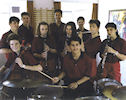 +names
+names
"Beat This!" from Chatterbox Magazine:
Thanks to the help of Ray Bulpit and the Thatcham and District Rotary Club, all costs were covered for the Mary Hare Band's three week tour of Eastern Australia. Over £1,000 was raised at a recent band concert alone and Australian Rotary Clubs helped with accomodation, transport and concert dates.
The itinerary included dates in Sydney and Canberra (at a reception with the High Commissioner). Bob Warren and Elaine Cookson also organised a visit to Forester High School, so the musicians were able to experience life in an Australian school.
The main aims of the tour were to promote the advantages of and the need of music for deaf children; to establish links with Australian schools; and to act as ambassadors for the U.K. Every opportunity was taken to appear on TV and radio, and there was some media interest.
The repertoire was versatile and very wide ranging, and Mrs. Rocca arranged pieces for the ensemble of flutes (Ruth Montgomery, Michelle Hall, Yvette Eyo); Clarinets (Suzanne Clubley, Danielle Gill, Kirsty McMullan, Melanie Pitts); violin (Natalie Smith); keyboard (Natalie Hewish); trumpet (Jamie Wilson); bass guitar (Sam Pitts); and percussion (Bryan Moore, Justin Smith).
The staff who accompanied the group were Mrs Fenney, Miss May, Miss Roderick (now Mrs Rocca), Dr Rocca, Ms Gladwell, Mr Kelly (Clarinet teacher), and Miss Carter. Also accompanying was Mr Warren, a teacher from Australia, at Mary Hare for one year teaching geography. The band was called MAD (Dr. Rocca's idea!), and it stood for 'Musicians and Deaf'. I remember a few daft things off that trip. I put my hearing aids in my cup of tea by accident before going to bed. The next day I discovered them floating in the tea! I had to play that day without any hearing aids and it was a nightmare!
"On a High Note" from Chatterbox Magazine:
The junior and senior bands performed at the Area Music for Youth Festival, which was part of the National MFY (Music For Youth), during March 1995. Thirty students gave a moving performance of "Tears in Heaven", followed by a lively "Deepy Dippy", which the audience throughly appreciated. The high standard of the band was largely due to the committment of the music director, Mrs Rocca, and the large number of peripatetic staff teaching such a range of instruments.
"Reputed to be the Best" from Chatterbox Magazine:
The Mary Hare School music department is rapidly establishing a reputation as the foremost school for deaf musicians in Britain. Two recent pieces of news that have caused excitement are further top exam results and also a visit to The Royal Albert Hall to star in "Challenge Anneka". The school band was whisked out of school one Friday to take part in a concert, which was part of a challenge for Anneka Rice, screened in September. The large contigent of Mary Hare musicians, together with Evelyn Glennie, were a major feature on the exciting bill, which celebrated deaf achievements in the Arts.
"International Debuts" from Chatterbox Magazine:
Joining disabled musicians from Denmark, Thailand, Spain, Austria, Japan, and the USA, Ruth Monthgomery (flute), and Bryony Booth (clarinet) went to Moscow at the beginning of September for a week at the Moscow Conservatoire. The Classical Music Centre Ltd and Menatep Bank established an international foundation with the aim of using art and culture to integrate disabled children into Russian Society.
Vladislav Tererina (international concert pianist) had travelled worldwide but did not encounter other deaf musicians. At the recommendation of Evelyn Glennie he heard about the Mary Hare pupils, and selected Ruth and Bryony for this exciting opportunity.
After a week of master classes and rehersals, in a concert at the Grand Hall of the Conservatoire, Ruth performed the obligato of "Jesu, Joy of Man's Desiring" by Bach with an orchestra and a 100 male voice choir. Ruth with Bryony also played the "Air" from Handel's "Water Music" in a Russian Quintet. Montserrat Caballe and other international artistes were in attendence.
"No Stage Fright" The Band at the Anvil, from Chatterbox Magazine...
On Thursday 4th June 1998, the Mary Hare School Band went to the "Anvil" in Basingstoke to perform in a concert put on by the King Singers and Evelyn Glennie, which was part of their "Street Songs" tour around Britain.
After lunch, we all packed into the minibus and two cars and travelled to the "Anvil" in good time to rehearse on the stage before the concert started at half past seven. The hall was enormous. My eyes travelled around the hall searching for the top which seemed miles away. Many of us, including me, had never been to the "Anvil" before and so we had no idea that the hall might be this elegant. After a satisfying rehearsal and a chance to get a feel for the hall with the lights and the colossal height of it, we went for a walk aound the shops. Back in the dressing room with mirrors over the walls (unfortunately with no light bulbs surrounding them, much to our disappointment!) we got changed into our posh concert gear, which was strictly black and white (boy did we look smart!). We all chatted casually, keeping ourselves under control for our debut on the "Anvil stage". Most of us actually watched the first half of the concert.
We saw the King Singers and Evelyn Glennie play a variety of pieces, some together and some individually. My personal opinion was that the style of music played to us was very striking. In the hall the music circulated around making a remarkable experience to be involved in.
After the interval, we performed our pieces straight away: "Englishman in New York" by Sting, and "A Gaelic Blessing" by Rutter. Both pieces went really well and we were playing in front of 1500 people, so the sensation of that was truly phenomenal.
Some members of the staff of Mary Hare were in the audience so it was a real achievement knowing that we were showing people who did know us well, exactly what we could do, and that was, to play really well in front of lots of people.
Band members were Ruth Monthgomery (flute), Julia Spencer (flute), Matthew Steeple (saxaphone), Bryony Booth (clarinet), Krystal Wilson (clarinet), Sarah Gallaher (clarinet), Alicia Burzynska (clarinet), Beth Sewell (cello), Nicola Deverson (voice), Steven McMahon (drums), and Paul Bannister (piano).
"A Musical Day Out" from Chatterbox Magazine via Ruth Montgomery...
In the summer term, Ruth Montgomery, Bryony Booth, Danny Lane and I went to the Royal Academy of Music to record some pieces in a professional studio. Danny was extremely nervous but eventually felt privileged when he was playing on a Steinway. Out of all the pieces he played, I enjoyed Mozart's ninth sonata; its jaunty tune was rather catchy. Ruth eventually played her flute accompanied by Danny which went thoroughly well.
The 50th Anniversary Celebration of Arlington Manor was held on Saturday 26th June 1999, organised by the Mary Hare Grammar School and the Old Pupils Association. The music performance by Mary Hare pupils took place in Dulverton Hall and it was a great success. They were Bryony Booth (clarinet), Ruth Montgomery (flute), and Danny Lane (piano). There was a disco in the evening, where the School Band played.
In January, Mary Hare School's Senior Band helped to raise funds and awareness for the charity "Sign" by perforing at the "Feathers and Fizz" Ball at Henley-on-Thames to celebrate the charity's 18th birthday. The band played two sets of five pieces each during the evening. Band members were Harry Allen, Inderjit Johal, Justine Durno, Sannah Gulamsni, Fiona Biggs, Louise Saunders, Hattie Bowden, Kirsty Day, Rebecca Withey, Sam Calder, and Frankie Roberts.
In June, the Mary Hare School Band was invited to perform at a Celebrity Golf Event at Beaconsfield Golf Club in aid of the charity "Sign". The band, led by the Director of Music Christine Rocca, opened with a version of "The Year 3000" (by Busted), followed by Frankie Roberts singing a sultry "All That Jazz". Georgia Dalton perfomed her first solo, singing "Beautiful", which left at least two ladies in the audience with tears in their eyes.
In the same month, Mr. Gale travelled to the Russian Embassy in London to attend a reception and concert to mark the British launch of the Charity "Music of Life", which seeks to give musical opportunities to young people. Ruth Montgomery, represented the school and performed a movement from the Mozart Flute Concerto with great presence and grace. She was applauded loud and long by an appreciative audience that included the Ambassador and the renowned opera singer, Maria Guleghina, who also performed.
The BBC TV's production
See Hear! broadcast the profile of up-and-coming flautist, Ruth Montgomery, in two parts. This was followed by Ruth performing in St Peterburg and Moscow, Russia, with interviews on trials and tribulations of becoming a musician of high calibre. Mrs Rocca was also featured.
Article © 2006 Elaine Lavery, John A. Hay, Gordon Hay, Tilak Ratnanther
Website design © 2009 Kreb Dragonrider
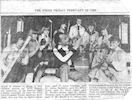
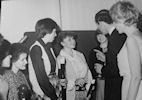
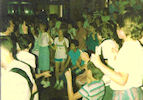
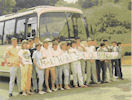
 +names
+names